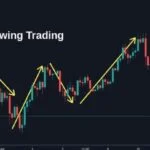Active traders can be divided into two categories: intraday traders and swing traders. Both aim to profit from short-term stock moves rather than retaining stocks for long-term gain. The fundamental distinction between the trading techniques is that intraday traders trade several stocks on the same trading day, whereas swing traders trade many stocks over a longer time period, often two days to a few weeks.
Knowing these variances can help traders decide which method best suits their goals and risk tolerance. Keep reading to learn more so that you can start your trading journey with the best trading app.
What is Intraday Trading?
Intraday trading refers to the purchase and sale of stocks on the same day. The major goal of using this strategy is to realize gains on purchased securities while also minimizing overnight risks.
Traders monitor intraday price movements using real-time charts they have chosen to profit from short-term price fluctuations.
Short-term traders often employ one-, five-, fifteen-, thirty-, and sixty-minute intraday charts while trading during the market day. Other intraday trading systems may employ 30- and 60-minute charts for trades with hold durations of several hours.
Advantages of Intraday Trading:
1. Lower Risk: As shares are purchased on the same day in intraday trading, the possibility of suffering overnight risk is reduced.
2. Higher Profits: Intraday trading is known to generate attractive profits for traders when proper trading tactics are used. To profit from a falling market, intraday share traders can also use the short-selling approach.
Challenges of Intraday Trading:
1. Higher Risk and Stress: Intraday trading is known for its quick speed, which can cause significant levels of stress. The pressure to make quick decisions, along with the volatility of intraday markets, heightens the risks of making emotionally influenced decisions.
2. Market Volatility: While intraday trading benefits from market volatility, it is equally vulnerable to the negative impacts of quick and severe price changes.
What is Swing Trading?
Swing trading, on the other hand, involves holding positions for several days to weeks. Swing traders aim to capture price movements or “swings” in the market.
This strategy allows traders to benefit from market trends and patterns without the need to monitor the market constantly.
This approach also provides flexibility, making it suitable for those who cannot dedicate full-time attention to trading, thus balancing risk and reward effectively. Additionally, swing trading reduces the emotional strain associated with day trading and offers ample time for market analysis and decision-making.
Advantages of Swing Trading:
1. Less Time-Consuming: Swing trading does not require the same level of constant attention as intraday trading. Traders can analyze the market after hours and make informed decisions.
2. Potential for Gains: By holding positions for a longer period, swing traders can capture more significant price movements, leading to potentially larger gains.
3. Lower Transaction Costs: Fewer trades mean lower transaction costs, making it a more cost-effective strategy.
Challenges of Swing Trading:
1. Overnight Risk: Holding positions overnight exposes swing traders to risks from after-hours news and events that can impact market prices.
2. Patience Required: Swing trading requires patience and discipline, as traders must wait for the right market conditions to realize gains.
3. Potential for Missed Opportunities: Longer holding periods may result in missed opportunities in other stocks or market sectors.
Choosing the Right Strategy: Intraday vs. Swing Trading
Deciding between intraday and swing trading depends on various factors, including your personality, lifestyle, and financial goals.
1. Risk Tolerance:
Intraday trading is more suitable for those with higher risk tolerance, as it involves frequent trades and exposure to market volatility. Swing trading, while still risky, may be more suitable for those who prefer a more measured approach.
2. Time Commitment:
If you have the time and ability to monitor the markets throughout the trading day, intraday trading might be a good fit. Conversely, if you have other commitments and cannot dedicate your entire day to trading, swing trading offers more flexibility.
3. Skill Level:
Intraday trading requires advanced technical analysis skills and the ability to make quick decisions. Swing trading, while still requiring analysis, allows for more thoughtful and deliberate decision-making.
Final Thoughts
In the world of online trading, there is no one-size-fits-all answer. Both intraday and swing trading offers unique opportunities and challenges. Whether you choose the fast-paced world of intraday trading or the more deliberate approach of swing trading, staying informed, disciplined, and adaptable will help you navigate the dynamic landscape of the stock market.











